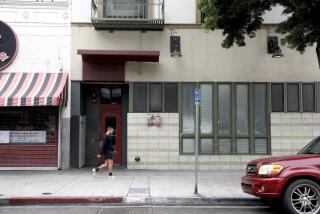State Assails Beverly Hills Over Lack of Affordable Housing : Government: The city is accused of failing to produce a plan to provide low-income dwellings. But its leaders insist that progress has been made even if strict compliance is lacking.
- Share via
Low-income housing in Beverly Hills?
The concept may sound strange, but state law requires Beverly Hills to file plans to provide its fair share of Los Angeles County’s housing--low-income included. And for nearly 10 years, state officials say, the city has failed to comply.
Every five years, each California city must file a plan, called a housing element, with the state, illustrating how it will provide a predetermined number of housing units. But state officials say Beverly Hills has not filed a satisfactory housing element since 1979. The next one came due in 1984.
This fall, prodded by a warning letter from the state attorney general’s office, Beverly Hills filed a draft housing plan with the state Department of Housing and Community Development. But housing officials said the plan fails to meet state requirements.
State officials had determined that Beverly Hills’ fair share of affordable housing should be 835 units, a third of which should be designated low-income. Although they did not know exactly how many affordable housing units are already in the city, state officials said the number falls well short of 835.
In a six-page letter sent last month to Beverly Hills City Manager Mark Scott, the state housing department said the city’s plan lacks adequate provisions for affordable housing. Further, the letter said, Beverly Hills did not invite representatives of low-income groups to help draft the plan.
“They are one of the worst cities in the state of California (in complying with housing laws),” said Carolyn Badenhausen, the department’s acting deputy director.
But Beverly Hills officials argue that the city has made strides in providing housing despite its lack of strict compliance.
“I don’t think it’s important to focus on why we didn’t do something; what we’ve been doing in the meantime is more important,” said Ruth Nadel, the city’s director of planning and community development.
Beverly Hills has been creating programs to help reduce housing costs for low-income residents, Nadel said. For example, she said, the city since 1989 has matched 61 people, most of them elderly, with roommates to save on rent. And it has contracted with handymen to provide 156 residents with up to $2,000 worth of minor home repairs each, free of charge.
In 1987, the city built 150 units of affordable housing on Crescent Avenue, Nadel said.
Still, none of these efforts have brought Beverly Hills into compliance with state housing law, and the city risks having the attorney general bring the matter to court--an option the state has not yet pursued.
Instead, the attorney general has written letters to the cities, including Beverly Hills, that are out of compliance, notifying them that their housing elements were inadequate.
Since those letters were sent, compliance statewide has risen from 19% of cities in 1991 to 52% today, Badenhausen said.
Beverly Hills’ first priority in complying with the law should be to rezone some areas to allow for multifamily housing development, she said.
But Nadel contends that multifamily housing units covering all income levels already dominate the housing market in Beverly Hills. She said city officials have been able to provide affordable housing in a city known for its wealth--even without a housing plan that complies with state law.
“It isn’t feasible to try and accomplish all of what (the state) requires,” Nadel said.
Badenhausen, however, maintains that there are other steps the city could take, such as providing subsidies for builders and landlords to develop affordable units and to rehabilitate older buildings.
Beverly Hills’ housing element also fails to detail how the city will use federal and state tax-credit funds to encourage developers to build low-income housing, state officials say. In addition, the plan does not identify sites where emergency shelters and transitional housing could be developed.
The next step for Beverly Hills is to come up with a new housing element and submit it to the City Council for approval.
If the city and state both sign off on the plan, Beverly Hills will be in compliance. There is no deadline for the city to complete this process, Badenhausen said.
Santa Monica also has a housing plan that is not in compliance with state law. But unlike Beverly Hills, she said, Santa Monica has been attempting to comply by regularly filing housing elements.
The housing element filed by Santa Monica officials in 1993 has prompted a lawsuit by two nonprofit groups--the Santa Monica Housing Council and the California Housing Council--and a Santa Monica resident.
The suit charges that Santa Monica is not trying to live up to housing goals set by the Southern California Assn. of Governments but rather has devised a housing plan with different goals. The case is scheduled for a hearing in Los Angeles Superior Court in May, said Chris Harding, an attorney with Lawrence & Harding, which is representing the plaintiffs.
In the meantime, the California Supreme Court is considering a request by the city of Santa Monica to intervene in the case before it goes to court.
Malibu is also not in compliance with housing law, but the state granted it an extension until next year to file a plan because Malibu is newly incorporated.
More to Read
Sign up for Essential California
The most important California stories and recommendations in your inbox every morning.
You may occasionally receive promotional content from the Los Angeles Times.






